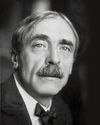
In September, 1870, while Prussian soldiers were trying to starve Paris into surrender, Claude Monet was in Normandy with his wife, Camille, and their son, Jean, looking for a boat out of France. They weren’t alone. Every day, hundreds of people went down to the docks in the hope of escaping the Franco-Prussian War; only later would Monet learn that some of his best friends had shoved through the same crowd. By November, he and his family had reached London, though they spoke no English. Months passed, and the Siege of Paris gave way to the Paris Commune and thousands of murdered civilians. The Monets moved on to the Netherlands, where Camille taught French and Claude painted canals. In photographs taken in Amsterdam around this time, their eyes look a decade older than the rest of them. They bought pots for a garden they might grow when the killing stopped.
Fleeing to two countries to avoid war was in some ways the rule, not the exception, of this artist’s life. He fled apartments to avoid creditors. He fled to the French coast to avoid the man whose wife he would marry. After getting married, he fled Paris for the calm of the countryside. He had some dozen addresses in five years, but it wasn’t the macho, Gauguin-in-Tahiti kind of fleeing that tends to turn into myth. If anything, Monet now stands for gardens and domestic coziness and knowing that the same things will be in the same places tomorrow—the kind of comfort, you could say, that matters most to someone for whom things often weren’t.
この記事は The New Yorker の September 23, 2024 版に掲載されています。
7 日間の Magzter GOLD 無料トライアルを開始して、何千もの厳選されたプレミアム ストーリー、9,000 以上の雑誌や新聞にアクセスしてください。
すでに購読者です ? サインイン
この記事は The New Yorker の September 23, 2024 版に掲載されています。
7 日間の Magzter GOLD 無料トライアルを開始して、何千もの厳選されたプレミアム ストーリー、9,000 以上の雑誌や新聞にアクセスしてください。
すでに購読者です? サインイン

HOLIDAY PUNCH
\"Cult of Love\" on. Broadway and \"No President\" at the Skirball.

THE ARCHIVIST
Belle da Costa Greene's hidden story.

OCCUPY PARADISE
How radical was John Milton?

CHAOS THEORY
What professional organizers know about our lives.

UP FROM URKEL
\"Family Matters\" and Jaleel White's legacy.

OUTSIDE MAN
How Brady Corbet turned artistic frustration into an American epic.

STIRRING STUFF
A secret history of risotto.

NOTE TO SELVES
The Sonoran Desert, which covers much of the southwestern United States, is a vast expanse of arid earth where cartoonish entities-roadrunners, tumbleweeds, telephone-pole-tall succulents make occasional appearances.

THE ORCHESTRA IS THE STAR
The Berlin Philharmonic doesn't need a domineering maestro.

HEAD CASE
Paul Valéry's ascetic modernism.